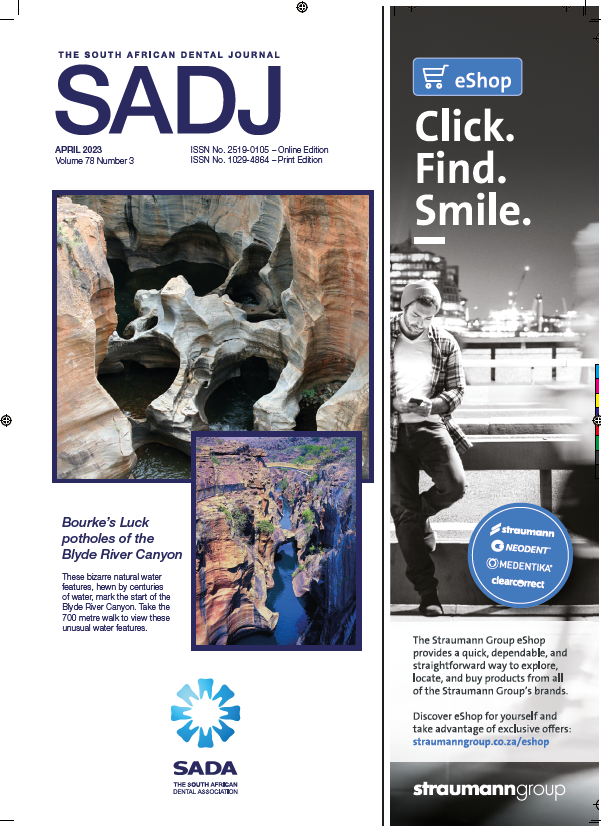Hard tissue characteristics of patients with bimaxillary protrusion
DOI:
https://doi.org/10.17159/sadj.v78i03.16269Keywords:
Bimaxillary protrusion, Black South Africans, facial profile, facial aestheticsAbstract
Bimaxillary protrusion (BP) is a common developmental condition amongst the South African Black population characterized by proclined incisors with resultant procumbency of the lips. The aim of this study was to perform a cephalometric radiographic analysis of the pre-treatment dental and skeletal structures in a sample of Black South Africans in order to identify the characteristic features of BP in this race group and compare them to norms. Records of 67 South African Black patients divided into 28 males and 39 females with a mean age of 17.8 years, clinically diagnosed with BP were included in the study. Cephalometric parameters were hand traced on lateral cephalometric radiographs and measurements recorded for evaluation and comparison to norm values used for this population group to determine the features that both males and females present with. Characteristic pre-treatment dental features of the sample
included maxillary incisors that were proclined and protruded with resultant decreased interincisal angle, mandibular incisors which were favourably positioned. Skeletal features included retrognathic jaws (maxilla to a greater degree) resulting in a mild to moderate Class III skeletal pattern but with females exhibiting a smaller ANB angle indicating a greater tendency for a Class III skeletal pattern. The skeletal growth pattern was vertically directed with an average anterior facial height ratio. The findings indicate that most BP patients in this South African Black population presented with dentoalveolar protrusion, retrognathic jaws and a mild to moderate skeletal Class III pattern
Downloads
References
Bills DA, Handelman CS, BeGole EA. Bimaxillary dentoalveolar protrusion: traits and orthodontic correction. Angle Orthod. 2005 May;75(3):333-9.
Dandajena TC, Nanda RS. Bialveolar protrusion in a Zimbabwean sample. Am J Orthod Dentofacial Orthop. 2003 Feb;123(2):133-7.
Huang YP, Li WR. Correlation between objective and subjective evaluation of profile in bimaxillary protrusion patients after orthodontic treatment. Angle Orthod. 2015 Jul;85(4):690-8. DOI: https://doi.org/10.2319/070714-476.1
Sivakumar A, Sivakumar I, Sharan J, Kumar S, Gandhi S, Valiathan A. Bimaxillary protrusion trait in the Indian population: A cephalometric study of the morphological features and treatment considerations. Orthodontic Waves. 2014;73(3):95-101. DOI: https://doi.org/10.1016/j.odw.2014.06.004
Keating PJ. Bimaxillary protrusion in the Caucasian: a cephalometric study of the morphological features. Br J Orthod. 1985 Oct;12(4):193-201. DOI: https://doi.org/10.1179/bjo.12.4.193
Fonseca RJ, Klein WD. A cephalometric evaluation of American Negro women. Am J Orthod. 1978 Feb;73(2):152-60. DOI: https://doi.org/10.1016/0002-9416(78)90185-9
Leonardi R, Annunziata A, Licciardello V, Barbato E. Soft tissue changes following the extraction of premolars in nongrowing patients with bimaxillary protrusion. A systematic review. Angle Orthod. 2010 Jan;80(1):211-6. DOI: https://doi.org/10.2319/010709-16.1
Beukes S, Dawjee SM, Hlongwa P. Soft tissue profile analysis in a sample of South African Blacks with bimaxillary protrusion. SADJ. 2007 Jun;62(5):206, 208-10, 212.
Dawjee SM, Becker PJ, Hlongwa P. Is orthodontics an option in the management of bimaxillary protrusion? SADJ. 2010 Oct;65(9):404-8.
Dandajena TC, Nanda RS. Bialveolar protrusion in a Zimbabwean sample. Am J Orthod Dentofacial Orthop. 2003 Feb;123(2):133-7. DOI: https://doi.org/10.1067/mod.2003.83
Lamberton CM, Reichart PA, Triratananimit P. Bimaxillary protrusion as a pathologic problem in the Thai. Am J Orthod. 1980 Mar;77(3):320-9. DOI: https://doi.org/10.1016/0002-9416(80)90085-8
Grimbeek JD, Cumber E, Seedat AK. Cephalometric analysis of black patients, South African Division Twenty-first Scientific Congress. 1987 Aug 31- Sep 2; Cape Town, South Africa.
Dawjee SM. The introduction of a new lateral cephalometric method and its potential application in open bite deformities. PhD Thesis. South Africa: University of Limpopo; 2010.
Wanjau J, Khan MI, Sethusa MPS. Applicability of the McNamara analysis in a sample of adult Black South Africans. SADJ. 2019 Mar; 74(2): 87-92. DOI: https://doi.org/10.17159/2519-0105/2019/v74no2a6
Naidoo LC, Miles LP. An evaluation of the mean cephalometric values for orthognathic surgery for black South African adults. Part II: Soft tissue. J Dent Assoc S Afr. 1997 Sep;52(9):545-50. Erratum in: J Dent Assoc S Afr 1997 Nov;52(11):677.
Jacobson A. The craniofacial skeletal pattern of the South African Negro. Am J Orthod. 1978 Jun;73(6):681-91. DOI: https://doi.org/10.1016/0002-9416(78)90229-4
Barter MA, Evans WG, Smit GL, Becker PJ. Cephalometric analysis of a Sotho-Tswana group. J Dent Assoc S Afr. 1995 Nov;50(11):539-44.
Drummond RA. A determination of cephalometric norms for the Negro race. Am J Orthod. 1968 Sep;54(9):670-82. DOI: https://doi.org/10.1016/0002-9416(68)90018-3
Diels RM, Kalra V, DeLoach N Jr, Powers M, Nelson SS. Changes in soft tissue profile of African-Americans following extraction treatment. Angle Orthod. 1995;65(4):285-92.
lhag SB, Abbas S, Ibrahim EK, Hashim HR, Sharfy A. Bimaxillary protrusion in a Sudanese sample: A cephalometric study of skeletal, dental and soft- tissue features and treatment considerations. J of Orthod Research. 2015;3(3): 192-8.
Tsai HH. Cephalometric characteristics of bimaxillary dentoalveolar protrusion in early mixed dentition. J Clin Pediatr Dent. 2002 Summer;26(4):363-70. DOI: https://doi.org/10.17796/jcpd.26.4.lqn08w5827576j60
Dale JG. Interceptive guidance of occlusion with emphasis on diagnosis. Alpha Omegan. 1999 Dec;92(4):36-43.
Ackerman JL, Proffit WR, Sarver DM, Ackerman MB, Kean MR. Pitch, roll, and yaw: describing the spatial orientation of dentofacial traits. Am J Orthod Dentofacial Orthop. 2007 Mar;131(3):305-10. DOI: https://doi.org/10.1016/j.ajodo.2006.05.032
Carter NE, Slattery DA. Bimaxillary proclination in patients of Afro-Caribbean origin. Br J Orthod. 1988 Aug;15(3):175-84. DOI: https://doi.org/10.1179/bjo.15.3.175
Aldrees AM, Shamlan MA. Morphological features of bimaxillary protrusion in Saudis. Saudi Med J. 2010 May;31(5):512-9.
Downloads
Published
Issue
Section
License

This work is licensed under a Creative Commons Attribution-NonCommercial 4.0 International License.





.png)